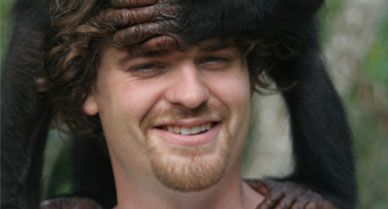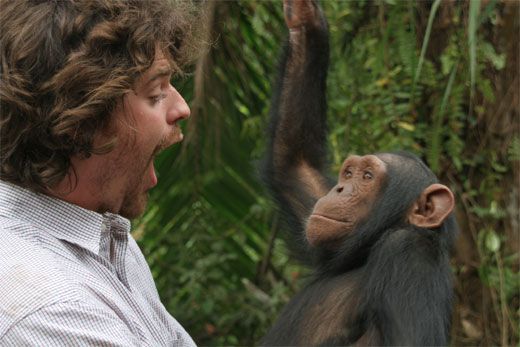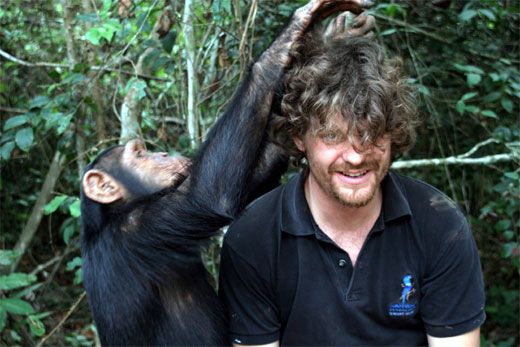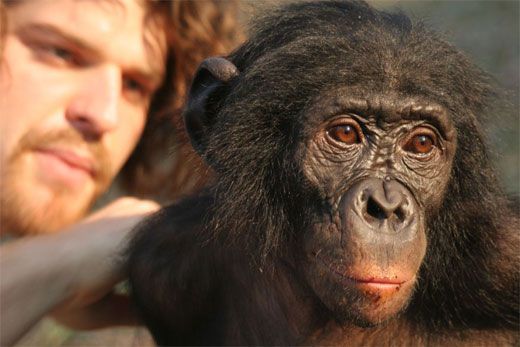Dogged
Primatologist Brian Hare investigates the social behavior of chimpanzees and bonobos in Africa. But dogs and foxes showed him the way
When Brian Hare started college in 1994, he apprenticed himself to a top chimpanzee researcher. His mentor, Michael Tomasello, was just beginning to investigate whether chimpanzees can understand what another chimp—or perhaps even a human—is thinking. Hare said such a skill couldn't be that difficult. After all, he told Tomasello, "my dog does that." Tomasello looked skeptical. And then he spoke the words that often inspire scientific discovery: "Prove it."
So Hare did. Using his parents' garage as his lab and the family dogs as his research subjects, the 19-year-old devised a simple experiment. When a dog wasn't watching, he hid a treat beneath one of two plastic cups. He then showed the dog the cups and either pointed to or looked at the one covering the treat. "They knew exactly what to do," he recalls. "They headed straight for the right cup and got their treat." (The dogs couldn't smell where the food was hidden.)
Although the results of Hare's experiment might not have surprised many dog owners, the study caught the attention of scientists who study animal cognition. At the time, most were hesitant to credit any animal with the ability to infer what another being is thinking—only humans were supposed to have that facility.
"These experiments test whether an animal is able to think about the thoughts of others, as we do," says Hare. "If you hide food and look at it, giving the dog a social cue, it should understand: ‘He's looking at where the food's hidden. He wants me to find it. And he knows where it's hidden, because he hid it.' "
But Hare didn't set out to study man's best friend—chimpanzees were what made him want to be a scientist. He dreamed of heading to the dense forests of East Africa, like his hero, Jane Goodall, to follow and study chimpanzees. "I'd seen a film about Jane when I was about 9," he recalls. "I thought, ‘Wow! I'm going to do that too!'"
That's why he joined Tomasello at Emory University's Yerkes National Primate Research Center in Atlanta. Oddly, though, when he and Tomasello investigated the ability of chimpanzees to follow a person's pointing finger or the direction of his gaze, the apes performed more poorly than the dogs. "I was surprised," Hare says. "After all, chimps are our closest relatives, and when you spend any time around them, you immediately see how smart and social they are."
Perplexed at the chimps' inability to follow a simple social cue, Hare resolved to delve deeper into their minds when he went to Harvard for his doctorate. He thought he'd go off to Uganda with Richard Wrangham, a primatologist who studies chimpanzees in Kibale National Park in Uganda. "But then Wrangham said he wanted me to go to Siberia to study some foxes," Hare says. "I thought, ‘Oh my god, I must have blown it! He's banishing me—I'm being exiled in Siberia.'"
Actually, Wrangham wanted Hare to look into an intriguing experiment at the Institute of Cytology and Genetics near Novosibirsk, Russia. Since 1959, researchers there had been breeding silver foxes for a single trait: compatibility with people. Foxes who readily approached people were allowed to breed; those showing fear or aggressive behaviors were disqualified from the gene pool (that is, made into fur coats). After 30 generations, the foxes' behavior had utterly changed. They'd not only lost their fear of people, but they were eerily like dogs. They ran up to people and wagged their tails. They evolved floppy ears, patterned coats, curly tails, and smaller teeth and bones.
Recent genetic studies have shown that dogs were domesticated from wolves—not foxes—so the scientists at Novosibirsk weren't simply recapitulating the origin of domestic dogs; they wanted to know how tameness could be bred. Wrangham suspected that the tame foxes could help Hare understand dogs. "I thought that the mere reduction of aggressiveness, resulting from domestication, might be the reason that dogs paid better attention to humans," says Wrangham. "I knew this hypothesis could be tested by studying these foxes and that Brian would think up a clever, creative experiment."
Hare already suspected that dogs had evolved the ability to understand human pointing signals sometime after they were domesticated from gray wolves about 15,000 years ago. "Wolves are more like chimps on these tests," says Hare. "From the first trial, the dogs—even puppies—just crushed the wolves. From the time puppies open their eyes, they can do it; it's not something they have to learn. And that means their ability to read human social cues must be something that has evolved since living with us."
But how had this understanding come about? Was it a result of humans choosing dogs that displayed the ability, or was it simply a side effect of the domestication package, as Wrangham suggested?
In Siberia, Hare found the foxes to be "absolutely adorable. They just want to jump in your arms." (But they have a musky stench, are hyperactive and would make "terrible pets," says Hare.) They also performed brilliantly on tests to understand human gestures, while a control group of normal foxes did not. "The fearless foxes hadn't been selected to be smarter," notes Hare. "They were selected for ‘niceness,' for being able to be handled, and that seems to have been the case with dogs too."
Thus, to get a smart dog—a dog that knows how to pull a sled or herd sheep or listen to your commands—you select the ones that aren't afraid or aggressive, that is, those that have evolved to keep their original wolf caution at bay. When fear is not a factor, human and dog can live and work together. "It really has nothing to do with what we think of as major cognitive abilities," Hare says. "It's far more simple and starts with emotional restraint."
Hare and others have speculated that social and emotional skills led to the evolution of intelligence in the great apes and humans. Since the 1970s, some scientists have claimed that animals are more likely to survive and reproduce if they are able to read social cues—to keep track of what other group members are up to and to deceive them if necessary. But Hare focuses on a slightly different type of social intelligence, the ability to work with others, regardless of whether they are strangers or rank lower in the social hierarchy. Hare's quest to find the primate roots of our social tolerance—and hence, according to him, our intelligence—brought him, finally, to living his original dream.
These days Hare, 31, studies chimpanzees and bonobos in sanctuaries in Uganda, the Congo Republic and Congo, when not at his home base at the Max Planck Institute in Leipzig, Germany. He has dozens of experiments underway at the sanctuaries, investigating the apes' social behaviors and how they affect the animals' ability to solve problems.
From these studies, Hare has come to have a better understanding of why chimpanzees fail seemingly simple tests. For instance, one experiment requires two chimps to pull on opposite ends of a rope at the same time. When they do, the rope moves a board and brings some tasty food within reach. "They all understand the problem, and they know what they need to do to solve it," he says. But only some chimpanzees succeed: the ones that—when their food bowls are placed close together—sit next to each other and feed peacefully. In most cases, either a chimp of lower rank won't eat in the presence of its superior, or the higher-ranking one attacks the other. These pairs fail to get the food on the board "because of social tensions. They can't get beyond that to work together," Hare says. "Only those chimps that eat together are able to cooperate to solve this task."
But bonobos, close relatives of chimps, relieve social tensions quickly and enthusiastically: when two or more bonobos, of either gender, encounter each other, they have a quick bout of sex. Then they settle down and work on the problem together. Bonobos ace Hare's tests.
There's a lesson here for us, Hare says. "It's true humans have bigger brains and language, and so forth. But we would not have evolved the kind of intelligence we have—the kind that allows us to use our brains together, to build things, to be mentally flexible—if we hadn't had a shift in temperament." That is, we had to become more like bonobos and less like chimps, which are high-strung, fearful of strangers and generally intolerant of any chimp lower on the social hierarchy. "We had to lose all those traits in order to become who we are," he adds. Controlling one's fears, paying attention to others, finding joy in working with others—that's the path to intelligence, he says, whether for dogs, apes or humans.
Virginia Morell has written about the Zuni, wildebeest migrations and the repair of the ozone hole for Smithsonian.



